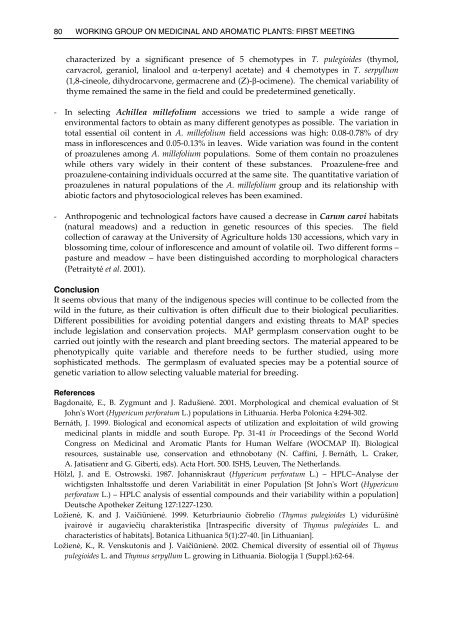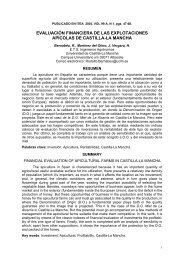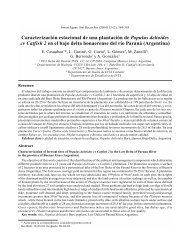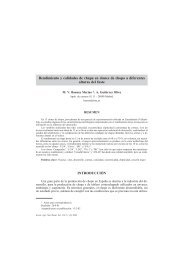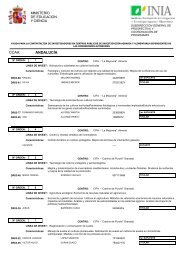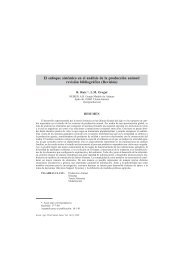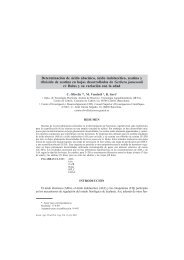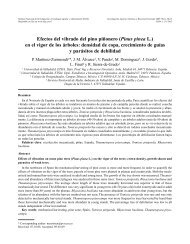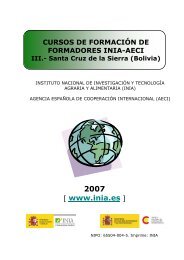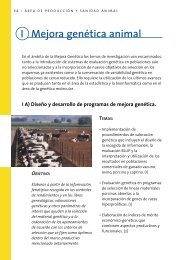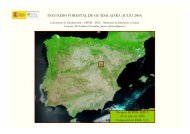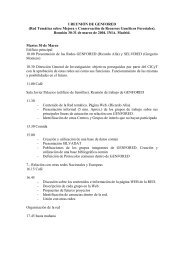Status of medicinal and aromatic plants in - Inia
Status of medicinal and aromatic plants in - Inia
Status of medicinal and aromatic plants in - Inia
You also want an ePaper? Increase the reach of your titles
YUMPU automatically turns print PDFs into web optimized ePapers that Google loves.
80<br />
WORKING GROUP ON MEDICINAL AND AROMATIC PLANTS: FIRST MEETING<br />
characterized by a significant presence <strong>of</strong> 5 chemotypes <strong>in</strong> T. pulegioides (thymol,<br />
carvacrol, geraniol, l<strong>in</strong>alool <strong>and</strong> α-terpenyl acetate) <strong>and</strong> 4 chemotypes <strong>in</strong> T. serpyllum<br />
(1,8-c<strong>in</strong>eole, dihydrocarvone, germacrene <strong>and</strong> (Z)-β-ocimene). The chemical variability <strong>of</strong><br />
thyme rema<strong>in</strong>ed the same <strong>in</strong> the field <strong>and</strong> could be predeterm<strong>in</strong>ed genetically.<br />
- In select<strong>in</strong>g Achillea millefolium accessions we tried to sample a wide range <strong>of</strong><br />
environmental factors to obta<strong>in</strong> as many different genotypes as possible. The variation <strong>in</strong><br />
total essential oil content <strong>in</strong> A. millefolium field accessions was high: 0.08-0.78% <strong>of</strong> dry<br />
mass <strong>in</strong> <strong>in</strong>florescences <strong>and</strong> 0.05-0.13% <strong>in</strong> leaves. Wide variation was found <strong>in</strong> the content<br />
<strong>of</strong> proazulenes among A. millefolium populations. Some <strong>of</strong> them conta<strong>in</strong> no proazulenes<br />
while others vary widely <strong>in</strong> their content <strong>of</strong> these substances. Proazulene-free <strong>and</strong><br />
proazulene-conta<strong>in</strong><strong>in</strong>g <strong>in</strong>dividuals occurred at the same site. The quantitative variation <strong>of</strong><br />
proazulenes <strong>in</strong> natural populations <strong>of</strong> the A. millefolium group <strong>and</strong> its relationship with<br />
abiotic factors <strong>and</strong> phytosociological releves has been exam<strong>in</strong>ed.<br />
- Anthropogenic <strong>and</strong> technological factors have caused a decrease <strong>in</strong> Carum carvi habitats<br />
(natural meadows) <strong>and</strong> a reduction <strong>in</strong> genetic resources <strong>of</strong> this species. The field<br />
collection <strong>of</strong> caraway at the University <strong>of</strong> Agriculture holds 130 accessions, which vary <strong>in</strong><br />
blossom<strong>in</strong>g time, colour <strong>of</strong> <strong>in</strong>florescence <strong>and</strong> amount <strong>of</strong> volatile oil. Two different forms –<br />
pasture <strong>and</strong> meadow – have been dist<strong>in</strong>guished accord<strong>in</strong>g to morphological characters<br />
(Petraitytė et al. 2001).<br />
Conclusion<br />
It seems obvious that many <strong>of</strong> the <strong>in</strong>digenous species will cont<strong>in</strong>ue to be collected from the<br />
wild <strong>in</strong> the future, as their cultivation is <strong>of</strong>ten difficult due to their biological peculiarities.<br />
Different possibilities for avoid<strong>in</strong>g potential dangers <strong>and</strong> exist<strong>in</strong>g threats to MAP species<br />
<strong>in</strong>clude legislation <strong>and</strong> conservation projects. MAP germplasm conservation ought to be<br />
carried out jo<strong>in</strong>tly with the research <strong>and</strong> plant breed<strong>in</strong>g sectors. The material appeared to be<br />
phenotypically quite variable <strong>and</strong> therefore needs to be further studied, us<strong>in</strong>g more<br />
sophisticated methods. The germplasm <strong>of</strong> evaluated species may be a potential source <strong>of</strong><br />
genetic variation to allow select<strong>in</strong>g valuable material for breed<strong>in</strong>g.<br />
References<br />
Bagdonaitė, E., B. Zygmunt <strong>and</strong> J. Radušienė. 2001. Morphological <strong>and</strong> chemical evaluation <strong>of</strong> St<br />
John's Wort (Hypericum perforatum L.) populations <strong>in</strong> Lithuania. Herba Polonica 4:294-302.<br />
Bernáth, J. 1999. Biological <strong>and</strong> economical aspects <strong>of</strong> utilization <strong>and</strong> exploitation <strong>of</strong> wild grow<strong>in</strong>g<br />
<strong>medic<strong>in</strong>al</strong> <strong>plants</strong> <strong>in</strong> middle <strong>and</strong> south Europe. Pp. 31-41 <strong>in</strong> Proceed<strong>in</strong>gs <strong>of</strong> the Second World<br />
Congress on Medic<strong>in</strong>al <strong>and</strong> Aromatic Plants for Human Welfare (WOCMAP II). Biological<br />
resources, susta<strong>in</strong>able use, conservation <strong>and</strong> ethnobotany (N. Caff<strong>in</strong>i, J. Bernáth, L. Craker,<br />
A. Jatisatienr <strong>and</strong> G. Giberti, eds). Acta Hort. 500. ISHS, Leuven, The Netherl<strong>and</strong>s.<br />
Hölzl, J. <strong>and</strong> E. Ostrowski. 1987. Johanniskraut (Hypericum perforatum L.) – HPLC–Analyse der<br />
wichtigsten Inhaltsst<strong>of</strong>fe und deren Variabilität <strong>in</strong> e<strong>in</strong>er Population [St John's Wort (Hypericum<br />
perforatum L.) – HPLC analysis <strong>of</strong> essential compounds <strong>and</strong> their variability with<strong>in</strong> a population]<br />
Deutsche Apotheker Zeitung 127:1227-1230.<br />
Ložienė, K. <strong>and</strong> J. Vaičiūnienė. 1999. Keturbriaunio čiobrelio (Thymus pulegioides L) vidurūš<strong>in</strong>ė<br />
įvairovė ir augaviečių charakteristika [Intraspecific diversity <strong>of</strong> Thymus pulegioides L. <strong>and</strong><br />
characteristics <strong>of</strong> habitats]. Botanica Lithuanica 5(1):27-40. [<strong>in</strong> Lithuanian].<br />
Ložienė, K., R. Venskutonis <strong>and</strong> J. Vaičiūnienė. 2002. Chemical diversity <strong>of</strong> essential oil <strong>of</strong> Thymus<br />
pulegioides L. <strong>and</strong> Thymus serpyllum L. grow<strong>in</strong>g <strong>in</strong> Lithuania. Biologija 1 (Suppl.):62-64.


